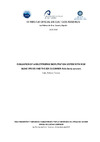Identificador persistente para citar o vincular este elemento:
https://accedacris.ulpgc.es/handle/10553/12387
| Campo DC | Valor | idioma |
|---|---|---|
| dc.contributor.advisor | Haroun, Ricardo | - |
| dc.contributor.advisor | Gómez-Pinchetti, Juan Luis | - |
| dc.contributor.author | Felaco, Luis | - |
| dc.date.accessioned | 2014-11-06T03:30:58Z | - |
| dc.date.accessioned | 2018-05-15T10:49:08Z | - |
| dc.date.available | 2014-11-06T03:30:58Z | - |
| dc.date.available | 2018-05-15T10:49:08Z | - |
| dc.date.issued | 2014 | en_US |
| dc.identifier.uri | https://accedacris.ulpgc.es/handle/10553/12387 | - |
| dc.description | Máster Oficial en Cultivos Marinos | en_US |
| dc.description.abstract | Aquaculture has been increasing rapidly in the past decades and it will continue to increase, this means that the release of nutrients associated with it will also increase; one of the proposed mitigation methods for this is the use of biofiltration systems and organisms. The aim of this study was to evaluate and implement potential new marine species with sediment and water biofiltration capacities of the nutrients from a landbased aquaculture production unit. The organisms associated with the effluents from two inland aquaculture facilities were studied; four species of algae were collected and tested for biofiltration and production under tank conditions Colpomenia sinuosa, Valonia utricularis, Ulva rigida and Schizymenia dubyi. H. sanctori was collected and placed in tanks with sediments from the aquaculture facility; total nitrogen and organic matter in the sediments were evaluated during a three week period where the effluents from the sea cucumber tanks were connected to Hydropuntia cornea tanks, the biofiltration and production of H. cornea submitted to the effluents was also tested, finally, a rope culture experiment with H. cornea, Grateloupia imbricata and Grateloupia turuturu was made at the biofilter facility of the PCT (Scientific and Technological Park of Taliarte). U. rigida presented the best growth rate, production and nitrogen uptake efficiency, followed by S. dubyi which presented the best nitrogen uptake rate. H. sanctori was an efficient biofilter of nitrogen in the sediments, returning them to the control conditions; they increased the amount of ammonia available for the growth of H. cornea although no significant differences were found in the growth rate, production, physiological state or biofiltration between H. cornea cultured with these effluents or directly from the effluents of the sedimentation tank, probably due to the little amount of ammonia present in both. The rope culture experiment showed that it would not be a useful method to stock algae at the biofilter facility from the PCT and a different operational approach increasing the surface for the natural growth of algae should be used. | en_US |
| dc.format | application/pdf | es |
| dc.language | eng | en_US |
| dc.rights | by-nc-nd | es |
| dc.subject | 251092 Acuicultura marina | en_US |
| dc.subject.other | Biofilter | en_US |
| dc.subject.other | Seaweeds | en_US |
| dc.subject.other | Holothuria sanctori | en_US |
| dc.subject.other | Sediments | en_US |
| dc.subject.other | Ecosystemic approach | en_US |
| dc.title | Evaluation of multitrophic biofiltration system with new algae species and the sea cucumber "Holothuria sanctori" | en_US |
| dc.type | info:eu-repo/semantics/masterThesis | en_US |
| dc.type | MasterThesis | en_US |
| dc.compliance.driver | 1 | es |
| dc.contributor.facultad | Facultad de Ciencias del Mar | en_US |
| dc.identifier.absysnet | 703385 | es |
| dc.identifier.crisid | - | - |
| dc.investigacion | Ciencias | en_US |
| dc.rights.accessrights | info:eu-repo/semantics/openAccess | es |
| dc.type2 | Trabajo final de máster | en_US |
| dc.description.notas | Máster Oficial en Cultivos Marinos ; 2012-2014. Trabajo presentado como requisito parcial para la obtención del Título de Máster Oficial en Cultivos Marinos, otorgado por la Universidad de Las Palmas de Gran Canaria (ULPGC), el Instituto Canario de Ciencias Marinas (ICCM), y el Centro Internacional de Altos Estudios Agronómicos Mediterráneos de Zaragoza (CIHEAM) | en_US |
| dc.utils.revision | Sí | en_US |
| dc.identifier.ulpgc | Sí | en_US |
| dc.contributor.buulpgc | BU-BAS | en_US |
| item.grantfulltext | open | - |
| item.fulltext | Con texto completo | - |
| crisitem.advisor.dept | GIR ECOAQUA: Biodiversidad y Conservación | - |
| crisitem.advisor.dept | IU de Investigación en Acuicultura Sostenible y Ec | - |
| crisitem.advisor.dept | Departamento de Biología | - |
| crisitem.advisor.dept | GIR IOCAG: Oceanografía Biológica y Algología Aplicada | - |
| crisitem.advisor.dept | IU de Oceanografía y Cambio Global | - |
| crisitem.advisor.dept | Departamento de Biología | - |
| Colección: | Trabajo final de máster | |
Visitas
183
actualizado el 01-mar-2025
Descargas
211
actualizado el 01-mar-2025
Google ScholarTM
Verifica
Comparte
Exporta metadatos
Los elementos en ULPGC accedaCRIS están protegidos por derechos de autor con todos los derechos reservados, a menos que se indique lo contrario.
